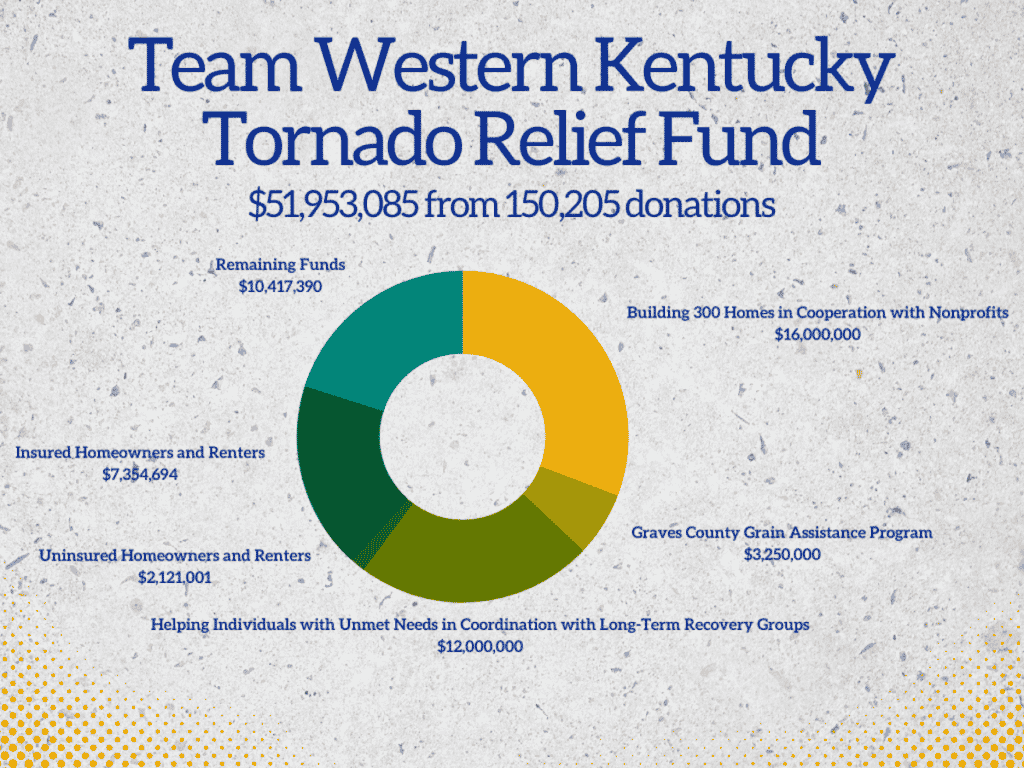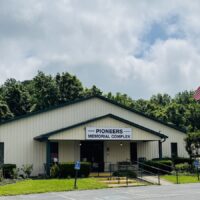Kentucky’s government is continuing to aid communities and individuals a little over seven months after a series of tornadoes devastated multiple counties in the western and central parts of the state.
Many communities along the storms’ paths have been hard at work recovering from the damage. There have been a variety of volunteer groups and charity organizations helping with recovery efforts across the state.
The Team Western Kentucky Tornado Relief Fund was online within 24 hours of the disaster, allowing people from across the state and country to donate to the recovery effort. The latest updates on the fund indicate roughly $52 million was donated by more than 150,000 people. In the past seven months, the money in the fund has gone to a variety of assistance programs.

The first thing the funding did was to pay for the funerals of all those who passed away due to the tornado outbreak. The money then matched part of the assistance people received from the Federal Emergency Management Agency and part of the deductibles of insured homeowners and renters who faced damage from the storm. In May, $16 million was given to three different charity organizations to help build 300 homes. In June, $3 million of the fund was allocated to create a grain assistance program for farmers dealing with new challenges navigating harvest season after the storm. Earlier this month, $12 million were set aside for a program where survivors can receive direct assistance from the fund through the long-term recovery groups in their communities.
Public Protection Cabinet Chief of Staff DJ Wasson gave the latest update on the fund’s use in July during a Legislative Oversight and Investigations Committee meeting.
“We received donations from all over, all over the nation,” Wasson said. “We had celebrities, we had corporations, we had people doing bake sales that just wanted to send in $5, $10 checks to us.”
Wasson said the goal was to streamline access to the funds, but in the initial aftermath people did not have access to the internet and their own personal documents. This limited how the PPC could verify needs in the early days after the storm.
So far, according to Wasson, there have been payments made in three programs – funeral assistance, additional funding for uninsured homeowners and renters, and additional funding for insured homeowners and renters. The other programs announced at this point are fund commitments, but their funding hasn’t been dispersed.
Roughly $10.8 million has been paid out of the Team Western Kentucky Tornado Relief Fund, with about $42 million already earmarked for specific uses.
“We also recognized that there were a lot of charitable organizations, a lot of volunteers that really wanted to provide assistance with some short term needs,” Wasson said. “So we did focus on longer term needs when we paid out our funding.”
The Public Protection Cabinet meets regularly with case managers to help avoid duplicate payments, but a lot of that has to do with what individuals report back to the state. For the payments that have already been made, the need has been verified through FEMA or an insurance company or the money has been sent directly to a funeral home.
“We’ve tried to put processes in place to address those and put controls in place to address those concerns,” Wasson said. “Ultimately, we do have to have a little bit of an element of trust, but we’ve tried to put those controls in place.”
The most recent General Assembly session established the State Aid Funding for Emergencies to help with the ongoing recovery process. This funding set aside $155 million of state money for different groups to apply for as needed throughout the recovery process. Since the funds started being distributed in April, a variety of organizations have received funding for various needs such as Hopkins and Taylor Counties receiving funding for debris clean up.
State Budget Director John Hicks from the Office of the State Budget said the SAFE Funds are reported on a regular basis to account for how that funding is being dispersed.
“We’re required on a monthly basis to report to the Interim Joint Committee on Appropriations and Revenue,” Hicks said. “The Department of Education, who got $30 million, they report, and then my office reports on the remainder [of the funds].”
The state also established the Commonwealth Sheltering Program, which provides travel trailers to tornado survivors who need medium-term housing as they navigate the recovery process. In January, Gov. Andy Beshear handed out the first set of keys for the program. By March, about 40 of the 200 trailers bought for the program had been handed out.
Earlier this month, Beshear announced that everyone who is eligible for a trailer from the Commonwealth Sheltering Program has been provided one. The program is managed by the Kentucky Transportation Cabinet and Kentucky Emergency Management.
Angie Van Berkel, public information officer for KYEM, said in an email that as of July 11, 226 people were being sheltered in 89 trailers. CSP also helped people find temporary housing in hotels and state parks. Across five hotels, there are 24 people being housed in 15 rooms. Additionally, there is one Kentucky State Park Cottage being used to house six people.
“The CSP was designed as a short to medium-term sheltering solution while survivors sought more permanent housing solutions,” Van Berkel said. “CSP will continue to provide sheltering to survivors until they have obtained long-term housing. Once a survivor has indicated that they have obtained long-term housing [and thus the travel trailer is no longer needed], CSP coordinates with the Finance Cabinet to properly surplus the state-owned property.”
Van Berkel said KYEM is working with different case management agencies to help survivors transition into more permanent housing solutions. She said all families in the program have been referred to some type of case management program.
“Deployed field teams are actively working directly with all the survivors to connect them to resources, encourage their continued participation in programs, such as FEMA Direct Housing, and provide a face for KYEM and the Commonwealth Sheltering Program to the survivors,” Van Berkel said.
Lily Burris is a features reporter for WKMS. She has a bachelor's degree in journalism from Western Kentucky University. She has written for the College Heights Herald at WKU, interned with Louisville Public Media, served as a tornado recovery reporter with WKMS and most recently worked as a journalist with the Kentucky Center for Investigative Reporting. In her free time, she enjoys reading, crocheting and baking.





